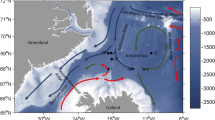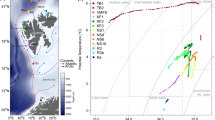Abstract
Open-water, marginal-ice and in-ice zones were sampled in the Weddell Sea during November and December, 1993 in an effort to examine the influence of the early spring bloom on the diet and population structure of the three biomass dominant copepods: Metridia gerlachei, Calanus propinquus, and Calanoides acutus. The abundance of all three species in the upper 200 m was highest at stations in the open water, but individually, each species displayed a unique trend. M. gerlachei, which showed the least variability, was significantly more abundant in open water than in the marginal-ice zone. The abundance of Calanus propinquus was higher in open water than in the marginal-ice zone or in the ice. Calanoides acutus displayed the highest variability, with significant differences between all three ice-cover zones. Diet analysis revealed no significant differences in the number of food items within each ice-cover zone and diatoms were the most numerous item identified in the guts of all three species. However, M. gerlachei and Calanus propinquus also contained metazoan material, while Calanoides acutus did not. There were dramatic differences in the age composition of the species between the zones. Early copepodite stages of all three species predominated at the ice edge and in open water. Numbers of M. gerlachei adult females were roughly equivalent in all three zones while Calanoides acutus and Calanus propinquus adult females composed a higher fraction of the total population within the ice. These results compare well with life-history data compiled by other authors and reinforce the importance of the ice edge to bloom-dependent Antarctic zooplankton.
Similar content being viewed by others
Author information
Authors and Affiliations
Additional information
Accepted: 5 April 1999
Rights and permissions
About this article
Cite this article
Burghart, S., Hopkins, T., Vargo, G. et al. Effects of a rapidly receding ice edge on the abundance, age structure and feeding of three dominant calanoid copepods in the Weddell Sea, Antarctica. Polar Biol 22, 279–288 (1999). https://doi.org/10.1007/s003000050421
Issue Date:
DOI: https://doi.org/10.1007/s003000050421




